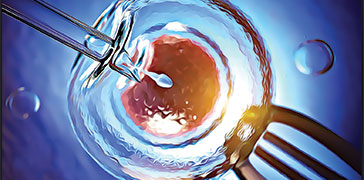US Pharm. 2023;48(9):15-16.

Used for More Than Infertility
Approximately 10% to 15% of couples in the United States will experience infertility. Significant advances in assisted reproduction have occurred in the past 40 years since the first person was born in 1978 due to in vitro fertilization (IVF). IVF is the most common type of assisted reproduction technology. It combines sperm with an egg outside the body to create a fertilized embryo. Today, in addition to assisting couples experiencing infertility, IVF has expanded to include managing medical and genetic conditions and as a method of preserving fertility. Approximately 2% of births in the U.S. are via IVF.
Promotes Successful Pregnancy
Successful pregnancy involves the completion of several complex physiologic events, including the production of viable sperm and eggs, delivery of sperm into the reproductive tract, movement of the fertilized embryo into the uterus, and implantation into the uterine wall. Infertility is defined as no conception after 12 months of unprotected sexual intercourse in women aged younger than 35 years or 6 months in women aged 35 years or older. It can result in abnormalities at any one or more than one of the complex physiological stages.
IVF is one of the most effective means of overcoming infertility and provides options for the conception of a healthy child where genetic risk is present or if pregnancy was delayed to later in life. The basic steps of an IVF cycle are ovarian stimulation, egg retrieval, fertilization, embryo culture, embryo transfer, and freezing of fertilized embryos. One IVF treatment cycle can take between 3 and 6 weeks. However, a person may require more than one cycle depending on her risk factors and the treatment success rate.
A Complex and Effective Process
The goal of the first stage of IVF is to stimulate multiple eggs because not every egg will fertilize or develop normally. Several different medications may be used. Injectable drugs containing a follicle-stimulating hormone, a luteinizing hormone, or a combination of both are used to stimulate more than one egg to develop at a time. When the eggs are ready for retrieval—usually after 8 to 14 days—human chorionic gonadotropin or other medications help the eggs mature. Sometimes different medications are given to prevent the body from releasing the developing eggs too soon. Finally, on the day of egg retrieval or at the time of embryo transfer, the doctor might recommend taking progesterone supplements to prepare the uterine lining to be more receptive to implantation. To monitor how the ovaries respond to the stimulation, fertility clinics use transvaginal ultrasounds and blood samples every few days.
Success Rate Improving Over Time
Retrieving the mature eggs involves a minor surgical procedure. The doctor will use a needle connected to a suction device to enter the vagina and retrieve the mature eggs. The eggs will then be fertilized in the laboratory, and they can also be screened and tested to determine sex and if there are genetic abnormalities. After about 3 to 5 days, the doctor will transfer one or more fertilized embryos back into the uterus, where they can continue to develop. The clinic may also cryopreserve (freeze) unused embryos for future cycles. IVF can be successful even with a few eggs retrieved, but success rates are higher when more eggs are recovered.
The success rate for IVF depends on several factors, including the age of the mother; the status of the embryo if the mother has given birth previously; and lifestyle factors such as weight, smoking, alcohol use, and excessive intake of caffeine. Many people will experience little to no side effects during IVF. Side effects are mainly a result of the medications used. Common side effects include fatigue, abdominal pain, sore breasts, irritability, nausea, headaches, and mood fluctuations. If more than one embryo is transferred, there is an increased chance of multiple births, which can increase overall risk of complications. With IVF, there is also the risk that the baby will be born prematurely or with low birth weight. Another rare complication is ovarian hyperstimulation syndrome.
The content contained in this article is for informational purposes only. The content is not intended to be a substitute for professional advice. Reliance on any information provided in this article is solely at your own risk.
To comment on this article, contact rdavidson@uspharmacist.com.





